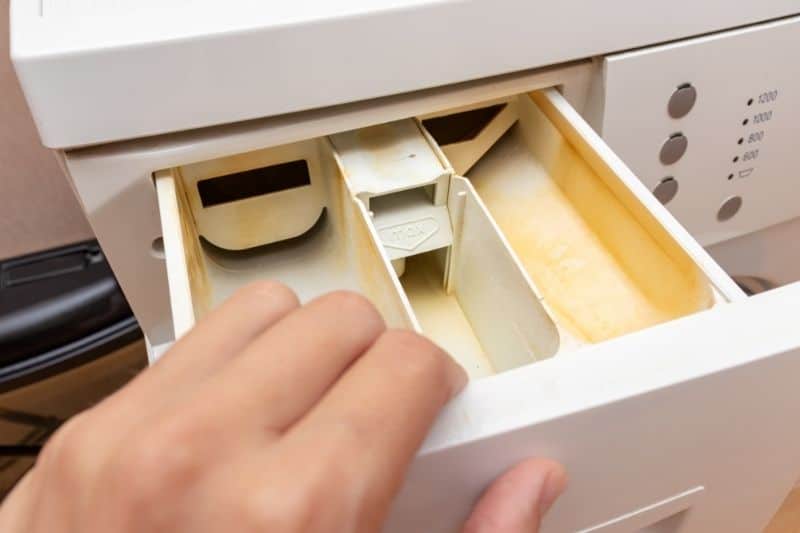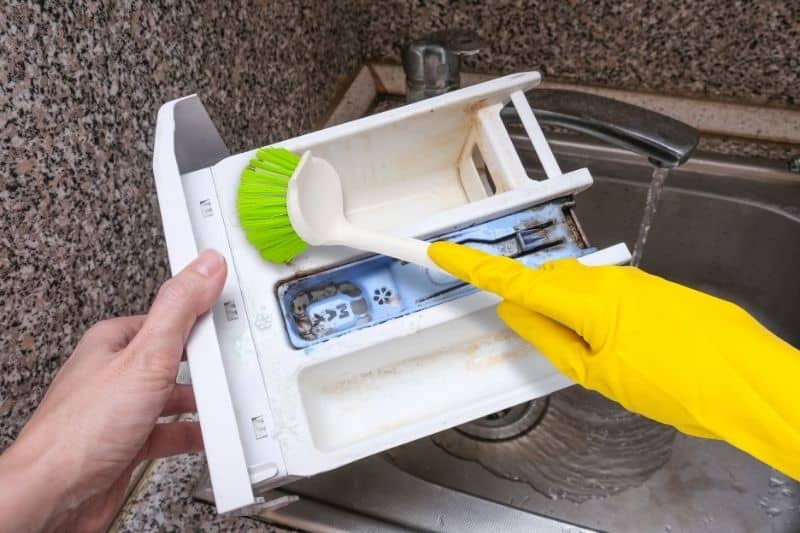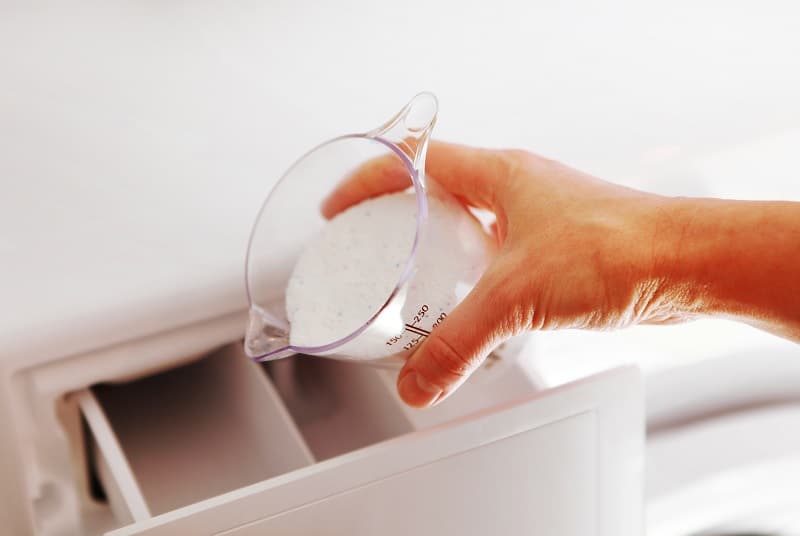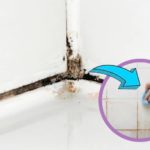The sad truth is that we’ve all seen mould inside of our washing machines in some way or another…
Where there’s damp, there’s usually mould not far behind, so don’t worry, it’s OK! We’ve got you covered because this post is going to tell you the best ways to get the mould out of the washing machine.
The washing machine drawer is one of the prime areas for mould growth, and it does look quite unsightly if left for too long.
Keeping on top of the cleaning of this area of your washing machine means you don’t have a mammoth scrubbing task later down the line.
It could also save your laundry from coming out smelling a bit musty or earthy. No one wants that, right?

What Causes Washing Machine Mould?
The front-loading design of most UK washing machines is so leak-proof, that it doesn’t dry out as quickly or easily (compared to a top-loading machine) and therefore becomes a bit of a breeding ground for moisture-loving mould.
It is also prone to the growth of black mould which can be dangerous to those with sensitive immune systems or respiratory conditions if not dealt with.

How to Clean Your Washing Machine Drawer
There are a few great products that can be used to make your washing machine detergent drawer clean as a whistle and remove any of the mould or soap scum that has built up over time.
- Bicarbonate of soda
- White vinegar – you could use a spray like this one on Amazon, or make your own by mixing white vinegar with equal parts water in a spray bottle
- Bleach or bathroom cleaner
- Scrubbing sponge
Here are the steps on how to clean mould from the washing machine drawer Mrs Hinch style! There’s even a great tip for how to clean mould from the washing machine drawer pipe, in that hard-to-reach area where all the smells harbour.
- Remove the drawer – Start by removing your washing machine detergent drawer – this will need to be cleaned separately in the sink.
- Scrub the drawer – Use your bathroom cleaner of choice, topped up with a little water to fill the scrubbing sponge and then start scrubbing the drawer. Use warm water to help loosen soap scum quicker.
- Clean inside the machine – Use the same sponge to clean inside the machine where the drawer once was. There will more than likely be mould on the “ceiling” and to the back of the space.
- Bring out the tools! – If you find that there are more stubborn areas of grime, you could enlist the help of a Sonic Scrubber or if you have an old electric toothbrush, now could be the time to give it a new lease of life as a house cleaning tool!
- Clean the edges and rubber seals – Don’t forget to scrub around the edges of the drawer opening and any rubber seals or hinges, depending on the design of your washing machine.
- Use bicarbonate of soda to remove odours – Now to combat the smells and to clean the drawer pipe, place a tablespoon of bicarbonate of soda into the drawer space and spray it with white vinegar. The powder will then froth up and start trickling down the pipe – the reaction of the vinegar and bicarb will neutralise any odours and should lift away any residual grime.
- Let it dry – Leave the drawer and drawer space to dry before replacing.
Natural cleaning method
If you’d rather not use any chemical cleaners, you could place your detergent drawer in a mix of hot water and vinegar and leave to soak for a while before scrubbing away soap scum and mould.
And of course, you can still use the bicarbonate of soda and vinegar trick for removing smells.
QUICK FACT: White vinegar can clean over 80% of mould species and can also help to prevent mould from returning. One of nature’s little cleaning wonders! See our guide on where to buy white vinegar for cleaning if you don’t already have some in your cleaning cupboard.
How Often Should You Clean the Washing Machine Drawer?
Carry out this detergent drawer cleaning once every month (or more if you prefer) to keep on top of this fabric softener and mould build-up and to keep your washing machine smelling fresh!
Now we’ve solved the problem of how to clean your washing machine drawer, there are plenty of other areas to target. Check out our post on why washing machines smell to find out more great washing machine cleaning tips!

In The Wash is your guide to the best laundry and cleaning products, tips and tricks. Our mission is to solve the UK’s cleaning and laundry dilemmas!






